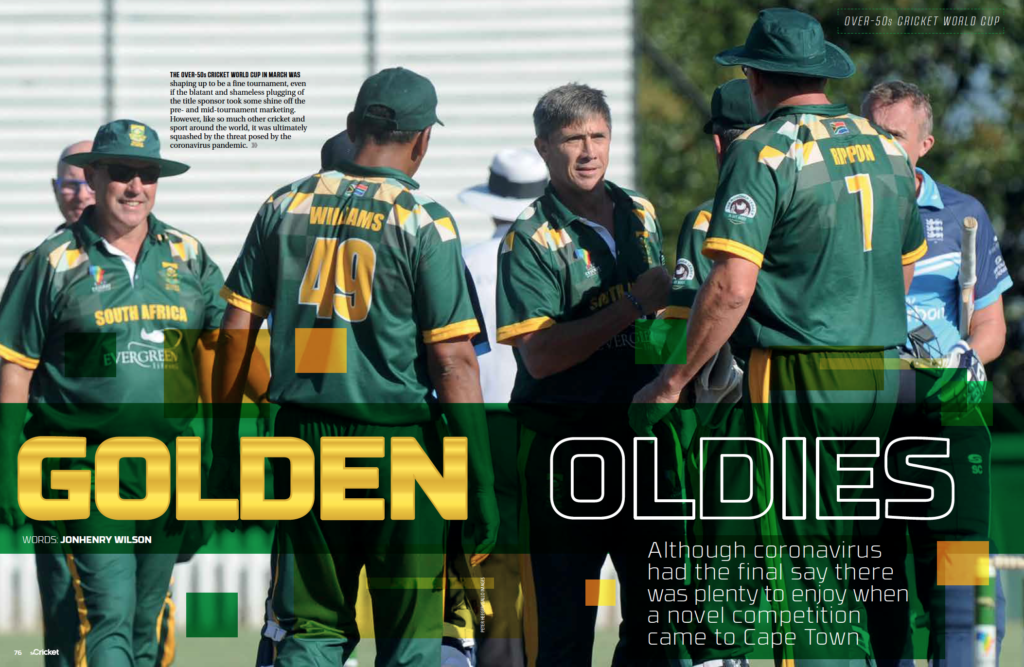Although coronavirus had the final say there was plenty to enjoy when a novel competition came to Cape Town.
The Over-50s Cricket World Cup in March was shaping up to be a fine tournament. However, like so much other cricket and sport around the world, it was ultimately squashed by the threat posed by the coronavirus pandemic.
A dozen of the scheduled 42 fixtures were completed, leaving 30 uncontested – and plenty of fans wondering how far South Africa, Australia, New Zealand, Pakistan and eight other countries could have gone in only the second edition of the tournament.
A highly anticipated event, replete with mass marketing at the Newlands T20I between the Proteas and Australia, a star-studded opening ceremony, live streaming and scoring, coverage from cricket’s most reputable platforms and more, this was by no means going to be a cursory campaign for crocked cricketers.
The inaugural Over-50s World Cup was hosted in Australia in 2018. The Aussies won that tournament and reaffirmed their status as favourites this time with a comfortable win over Zimbabwe and a tight victory over West Indies. South Africa, New Zealand and Pakistan were also undefeated front-runners.
Unfortunately, the woes that started in Wuhan and spread across the world eventually caught up with Cape Town – and the whole shebang was sidelined a mere five days into a two-week celebration of cricket for old-timers.
The day of the cancellation saw six matches capped at the halfway mark. Zimbabwe and New Zealand, in particular, spent the rest of that Sunday drinking and being merry. Their party left the match venue a bit worse for wear, but it typified the camaraderie and revelry that accompanied the tournament before its unfortunate, early end.
South Africa’s performances against Wales, England and India were a throwback to yesteryear, when Henry Williams and Alan Dawson were churning out wickets for Boland and Western Province respectively, and Dave Callaghan and Pieter Strydom were lapping up runs for Eastern Province and Border respectively. Dawson starred in SA’s wins over Wales and England, while Strydom and Anwell Newman were in the wickets against India before the lunch-time cancellation.
Callaghan, Williams, Dawson and Strydom were among five players with international experience in the South African squad. The other was Louis Koen – he played five ODIs between 1997 and
2000. Callaghan became the highest-profile name in the squad after Jonty Rhodes withdrew to instead play for South Africa Legends in Mumbai. South Africa were coached by Allan Donald, who must have found particular enjoyment in Williams’ role with the new ball and Dawson’s delivery at the death.
For others, it was a welcome opportunity to represent South Africa after failing to do so – for reasons vast and varied – in the past. The extensive first-class experience of Bradley Player and Kenny Jackson aided a squad that also included David Duncan, Neil Fusedale, Mlungisi Ngece, Rodney Malamba, David Holgate, Bruce Wilson, Warne Rippon and Nazeem White.
The calibre of play was good throughout the event. This wasn’t ‘village’, but vintage cricket. Some of the other nations boasted players of international experience, too. Mark Alleyne (above right), who collected 10 ODI caps in the late 1990s and early 2000s, captained England. Having competed against Jacques Kallis in Cape Town in 2000, Alleyne returned to the city 20 years later to play on the Wynberg Boys’ High School oval named after the iconic Proteas cricketer.
Carl Hooper was named in the West Indies’ provisional squad, but didn’t make the final cut. Zimbabwe had Eddo Brandes, Craig Evans and Mark Burmester – three names synonymous with the country’s cricket in the 1990s. Brandes, closer to 60 than 50 years old, exemplified some of the fine fitness levels witnessed during the geriatrics’ games.
This Over-50s Cricket World Cup coincided with the Road Safety World Series in India, where Rhodes, Herschelle Gibbs, Jacques Rudolph and other names admittedly bigger than Strydom, Dawson, etc, were also rekindling their cricketing youth. Events in Mumbai didn’t overshadow those in Cape Town, though, and it’s a genuine pity – but completely understandable – both were brought to a premature end.
MOST RUNS
Pakistan’s Sajid Ali was the tournament’s top run-scorer. More than 20 years since the last of his 13 ODIs, the former teammate of Inzamam-ul-Haq, Wasim Akram and Waqar Younis, the 56-year-old right-hander welcomed a maiden century in international cricket – albeit it at a pseudo level. He pledged more with 25 and 29 against Nambia and India respectively, before hitting a fine 124 not out against Wales for a total of 178 runs in three innings at an average of 89.00. His patient 140-delivery stay against the Welsh was a fitting foil to the big-hitting Muhammad Javed’s 133 from 84, which included 10 fours and nine sixes. Alan Dawson (above) was the top-scorer for South Africa. He also capitalised against the Welsh, walloping six sixes across the Boon Wallace Oval at Cape Town Cricket Club en route to a thrilling 69 not out from 35 deliveries. In the end, he had 88 runs from two knocks, outstripping countrymen and specialist batsmen Dave Callaghan, Pieter Strydom, David Duncan and others.
MOST WICKETS
Stephen Foster (above) starred for England during the 2018 Over-50s World Cup, snaring six-wicket hauls against Sri Lanka and New Zealand. He wasn’t as prolific in this year’s tournament, but took a total of eight wickets against India, South Africa and Namibia to finish as the joint-top wicket-taker alongside Canada’s David Mohamed. The Canadian’s eight wickets, too included a five-for against Sri Lanka. His 5-24 wasn’t the best haul, though, as England’s Mo Shahnawaz completed 5-15 against Namibia. Pieter Strydom and Anwell Newman were the top wicket-takers for South Africa, with five from three matches each.
CAPE TOWN CRICKET CLUB SPOTLIGHT
The Over-50s Cricket World Cup had its headquarters at Cape Town Cricket Club, with tournament organiser Roger Moult a life member at the humble and historic community club in Plumstead. The club’s Boon Wallace Oval hosted South Africa’s opening match against Wales to much fanfare, which almost trebled after the club’s David Holgate was named among the squad’s other illustrious names.
‘Only in my wildest dreams did I think it possible that I would represent my country in international cricket. I’ve been putting in extra gym and cricket training sessions to be as prepared as possible,’ he said. ‘It’s tough finding the time while trying to run a business, as well as dealing with a few injury niggles along the way. It’s also difficult as a wicketkeeper-batsman as you need to find time to practise both disciplines.’
Holgate’s inclusion in the SA Over-50s squad came in the same period when Cape Town Cricket Club’s Kyle Verreynne was being blooded by the Proteas. Verreynne, in fact, was named in the Proteas squad for February’s ODI series against England the same week he turned out for Cape Town Cricket Club in the Western Province Cricket Association premier league against Victoria Cricket Club. His appearances for CTCC were, of course, otherwise limited by Cape Cobras commitments. One of the club’s other franchise graduates, David Bedingham, was also in the news at the time. He has left for Durham in the United Kingdom – not on a Kolpak contract.
THE COVID-19 EFFECT
The Over-50s World Cup was among the last of several tournaments and series to be postponed or cancelled due to the spread of the virus. While other sports set an early precedent, the Everest Premier League was the first to go for cricket. It was followed by the cancellation of the T20I series between the World XI and Asia XI in Bangladesh, where Faf du Plessis and Lungi Ngidi were scheduled to play.
Next went the Australian Women’s tour of South Africa, the Proteas’ ODI tour of India and New Zealand’s limited-overs series in Australia. When Australian seamer Kane Richardson and New Zealand fast bowler Lockie Ferguson were tested for the coronavirus, the impact seemed that much closer to home for cricket fans. Both eventually tested negative. Towards the end of March, the start of the Indian Premier League was moved from late March to mid-April. It might be played behind closed doors, or not at all.
In the wake of Cricket South Africa’s mid-March decision to suspend all forms of cricket for 60 days, the Northerns Cricket Union and Western Province Cricket Association labelled the virus an ‘outbreak’ and ‘natural disaster’ respectively – dubious terminology in a period that demanded careful wording.







